Optimizing your website or ecommerce store is the key to improving user experience, increasing conversions, and driving more sales. And this is where A/B testing tools come in. They allow you to test different versions of your website, or elements within your website (copy, graphics, aesthetics, layout etc.) to see which ones perform better.
What is A/B Testing?
A/B testing is a controlled experiment, also known as split testing. It’s used in website optimization to compare two different versions of a web page in order to determine which one performs better.
Here is how it works:
- A website’s traffic is divided into two groups
- Each group is shown a different version of a webpage
- Conversion rates and other metrics of each group are measured
Performance data obtained from A/B testing is used to decide which version of the website attracts more traffic, sees more clicks, more time spent on the page, or which version of the user experience is most effective.
So when you make a specific change to a website, A/B testing gives you data that will help you understand how the change affects user behavior on your website. You also find out what changes lead to better results.
How You Can Use A/B Testing
Optimizing Product Pages
If you want to improve conversions rates on your product pages, you can perform A/B testing on different elements like: product images, product descriptions, and call-to-action buttons in order to identify the variations that resonate best with your target audience.
Checkout Page
If you want to reduce abandoned carts and increase your revenue, you can implement A/B testing on the design of your checkout page, different payment options, and also shipping methods. This will help you see which elements have the best checkout results so you can optimize your website accordingly.
User Experience
User experience can make or break an online business. Poor experience results in high bounce rates. A/B testing different layouts, headline styles, and content placement allows you to identify variations that increase user engagement with your website.
Benefits of A/B Testing in Website Optimization
Your overall website optimization strategy will benefit immensely from A/B testing. Here are some of the key benefits:
Improved Conversion Rates
A/B testing allows businesses identify and optimize the elements that have the highest impact on user behavior. They can gauge what combination of elements drive high conversion rates.
Enhanced User Experience
A/B testing helps business gain valuable insights on user preferences and behavior. This information is then used to refine user experience by creating changes that make using the website more intutive, engaging and enjoyable.
Data-Driven Decision Making
Making decision without data is perilous to the survival of a business. A/B testing eliminates guesswork and provides that helps businesses make informed decisions.
Increased Revenue and ROI
When you optimize your website based on results from A/B testing, you unlock potential for increased revenue, customer satisfaction, and more. A/B testing should be a continous process.
When it comes to A/B testing tools for website optimization, there are several options to choose from. Here are some of the top tools available today:
1. Optimizely
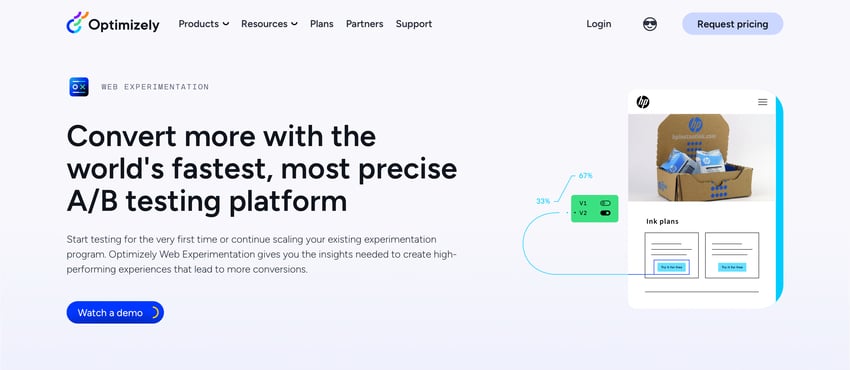
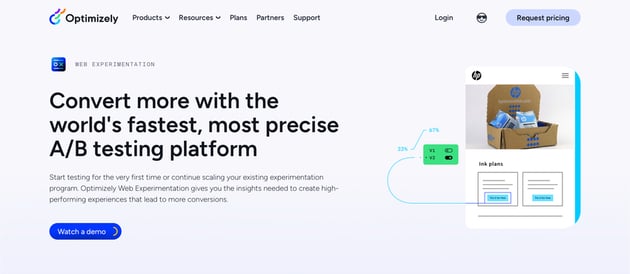
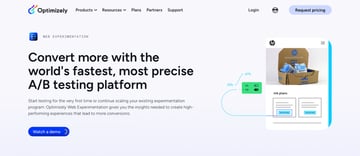
Optimizely is a widely recognized A/B testing tool that offers a user-friendly interface and powerful features. It allows users to create and test different variations of webpages without the need for coding knowledge.
Users can do A/B testing, multivariate testing, and split testing. It has advanced targeting and personalization capabilities, enabling businesses to deliver personalized experiences to specific audience segments.
Optimizely integrates with Google Analytics, Google Ads, Firebase, AMP, and Stripe payment gateway.
“Optimizely One is the world’s only DXP with AI fully-embedded across its entire suite.”
2. VWO
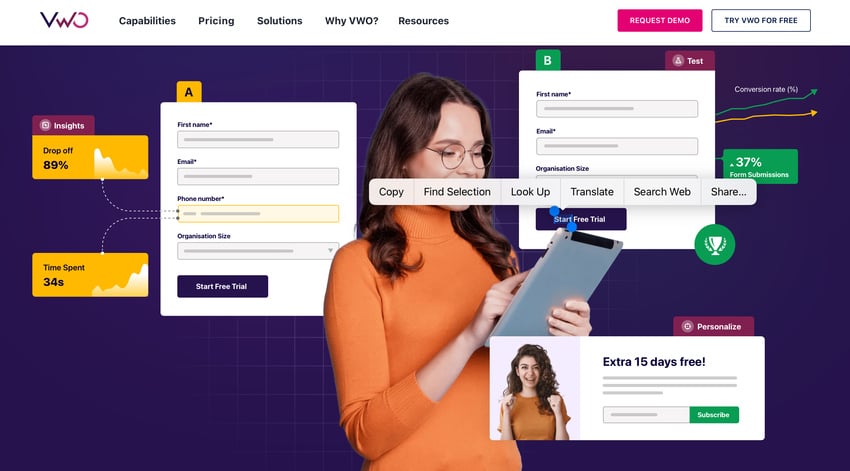
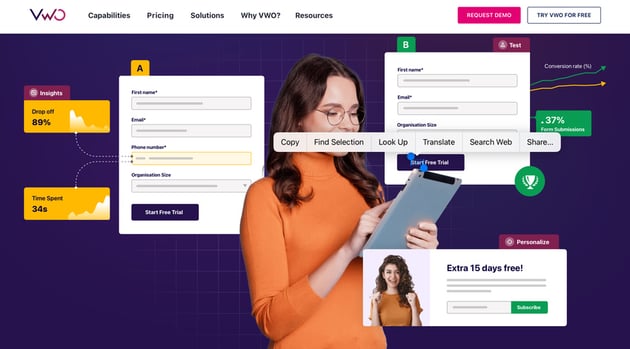
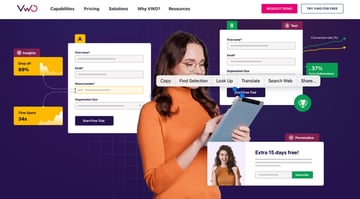
VWO is a comprehensive A/B testing and conversion optimization tool. It offers an intuitive visual editor that makes it easy to create and test different variations of webpages. You can do website testing, mobile app testing, server side testing.
VWO provides advanced targeting options, segmentation capabilities, and deep integration with third-party tools like Google Analytics, making it a powerful solution for website optimization.
“We integrated Open AI’s GPT-3.5 Turbo API with our Visual Editor so that every time you decide to run a test or deploy a change, you can generate copy recommendations that you can choose to create variations out of.”
3. FigPii
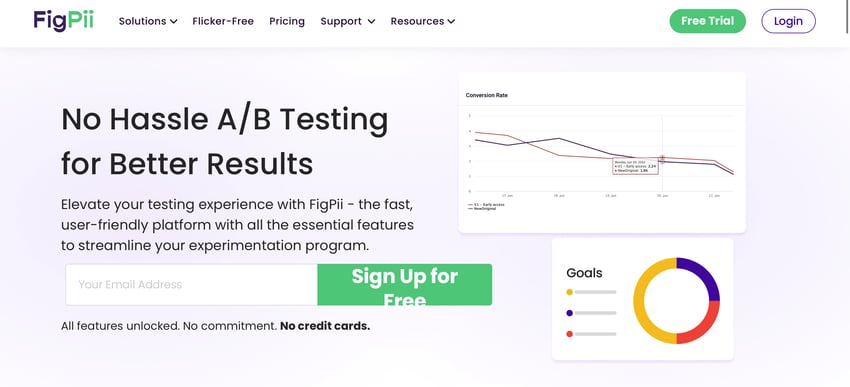
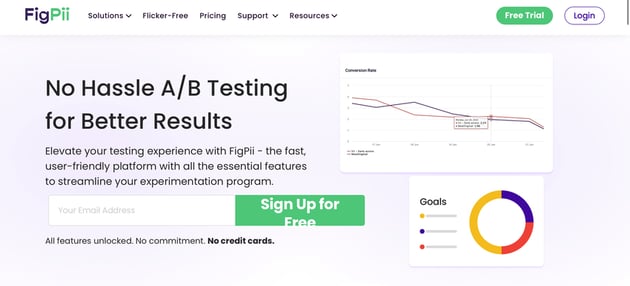
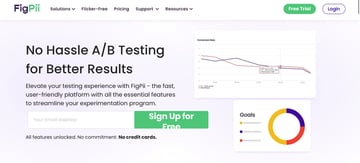
Figpii employs machine learning to understand how users navigate your website and determine the most effective way to configure and initiate A/B testing for maximum conversions.
On Figpii, you may access heatmaps, session records, site surveys, and advanced targeting.
Additionally, it allows for connectivity with other programs like WordPress, Magento, Unbounce, and Shopify. It is however not compatible with A/B testing on mobile applications. Figpii offers a 14-day free trial during which you can use every function on the platform.
“Go beyond A/B testing and unlock the potential of Split URL Tests, seamless Deployments, and personalized AI-driven testing recommendations.”
4. Convert
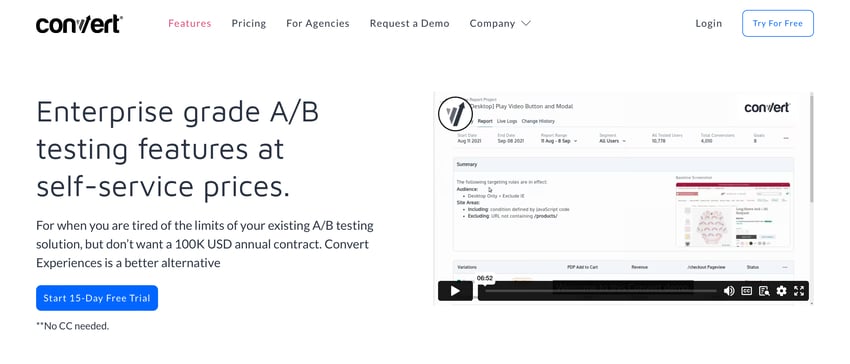
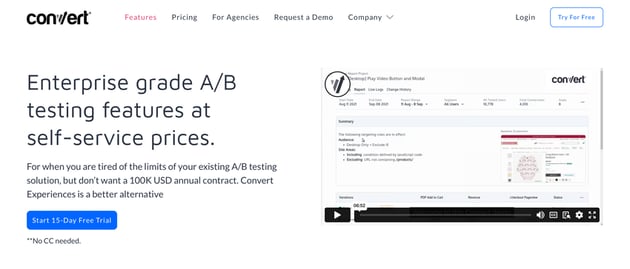
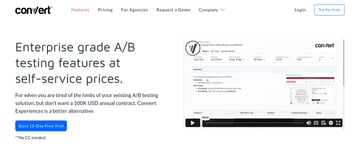
Convert is an enterprise-level A/B testing and personalization tool that caters to the needs of larger organizations. It offers advanced features such as multivariate testing, audience segmentation, and deep integration with analytics tools.
Convert’s powerful API and comprehensive reporting capabilities make it a preferred choice for businesses looking for a highly customizable and scalable A/B testing solution.
“Convert will continue to only introduce AI tools IF AI can legitimately solve a (real) problem better than existing resources.”
5. AB Tasty
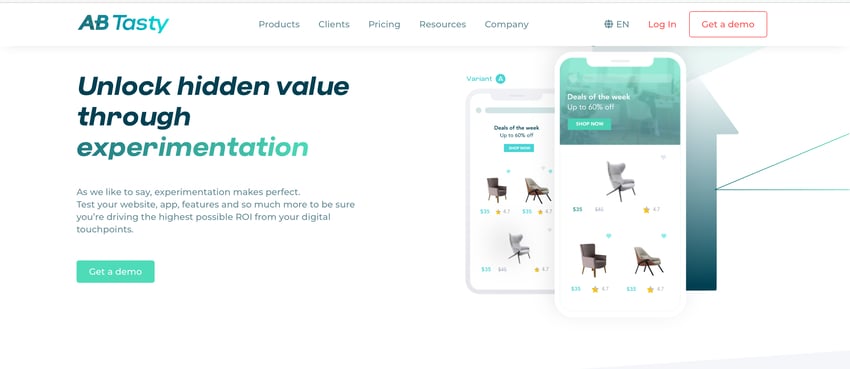
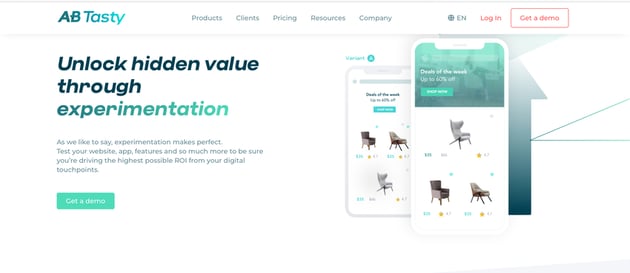
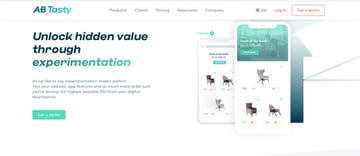
AB Tasty is a user-friendly A/B testing and personalization platform that helps businesses optimize their websites and improve conversion rates.
It offers an intuitive visual editor, advanced targeting options, and robust analytics capabilities.
AB Tasty also provides additional features like heatmaps, session recordings, and AI-driven insights, enabling businesses to gain valuable user behavior insights for optimization purposes.
“When it comes to experience optimization, artificial intelligence allows you to go faster, be more precise and drive better results, without the gruntwork.”
6. Adobe Target



Adobe Target is part of the Adobe Experience Cloud suite of products and offers advanced A/B testing and personalization capabilities. It offers insights that allow easy website owners to make choices on the best way to deliver their content to users.
It provides a comprehensive set of features, including multivariate testing, segment-based targeting, AI-driven personalization, and integration with other Adobe products like Adobe Analytics and Adobe Campaign.
The drawback is that access to the majority of the tool’s sophisticated functionality necessitates a subscription to other Adobe analytics products
“AI is critical to modern optimization. Test the experience and personalize it to every visitor, applying artificial intelligence with a single click.”
7. SiteSpect
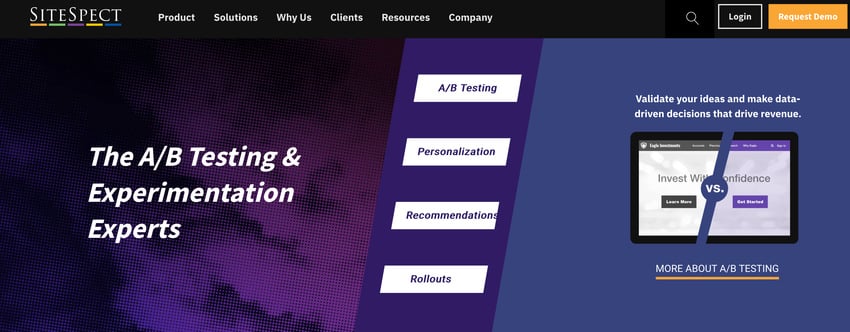
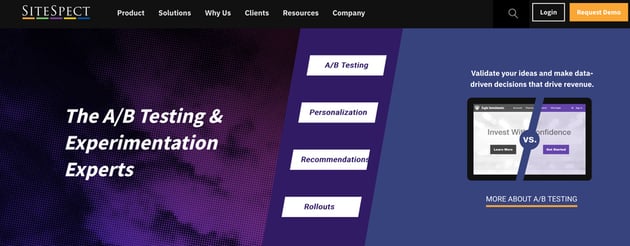
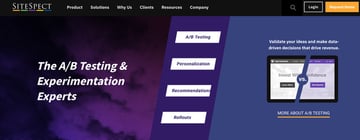
SiteSpect is an enterprise-level A/B testing and optimization platform. When it comes to testing and targeting, it offers multivariate testing, audience segmentation, and behavioral targeting.
It is the perfect choice of enterprise-level organization because of the emphasis it places on security and performance and comprehensive reporting and analytics.
“SiteSpect offers the only code-free product recommendations solution. Even non-technical users can add AI-driven product recommendations anywhere, on any page, and fully test any aspect of those recommendations.”
8. Tubebuddy

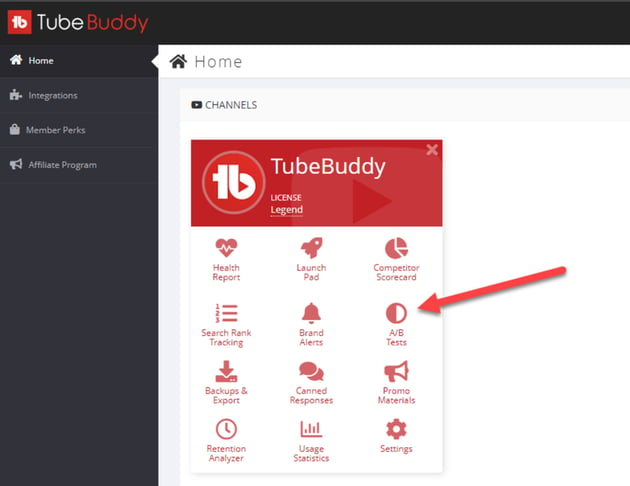
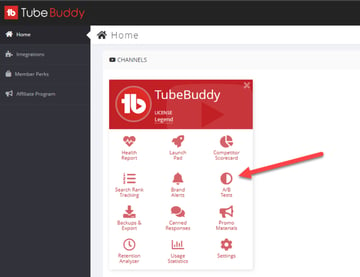
One of the most widely used YouTube SEO tools available is TubeBuddy. It supports YouTube Creators in effectively managing, growing, and optimizing their YouTube channel.
It can be downloaded for free as a browser extension, and when combined with your YouTube dashboard, it offers an incredible amount of features! The tool is easy to use, can do bulk editing and has excellent A/B testing.
“Use our AI to analyze your thumbnails and give you predictive scores to see how likely your audience is to click on them.”
When selecting an A/B testing tool for website optimization, it’s important to consider the following factors:
Ease of Use and Implementation
A tool that offers zero to no learning curve is ideal. For this reason, go for a tool that requires minimal technical expertise. Also, look for features like:
- a user-friendly interface
- visual editor
- drag-and-drop functionalit
- no-code implementation of testing and optimization processes
Integrations with Existing Tools
Compatibility with your tech stack is important. You want to integrate the A/B testing tool with your CRM tools, CMS, etc to ensure a smooth workflow and data consolidation.
Targeting and Personalization Capabilities
When evaluating the targeting and personalization capabilities of the tool, ask if it can do audience segmentation and behavior targeting. Finally, look for AI-driven personalizations in order to deliver tailored experiences to specific user groups helps optimize conversions.
Support and Customer Service
Ensure that the A/B testing tool provides:
- dedicated support teams ready to address any issues that may arise
- resources like documentation
- video tutorials
Scalability
Here are some questions to ask:
- Can the tool handle high traffic volumes?
- Can it accomodate future growth while maintaining top notch user experience?
- Can it grow with your enterprise?
Price and Cost-Effectiveness
Here are some questions you should ask:
- Does the pricing plan suit your budget?
- Do you get the bang to your buck when it comes to features, functionality, and support?
- Does price plan cover all your optimization goals?
Best Practices for A/B Testing
To make the most out of A/B testing, it’s important to follow these best practices:
1. Clearly Define Goals and Hypotheses
The first thing to do, before running any A/B testing, is to define your objectives and hypothesis clearly. This will make testing easier and will also guarantee that optimizations you make have impact.
2. Test One Element at a Time
Test one element at a time. This eliminates imprecision and ambiguity, removes confusing variables, and makes way for accurate analysis. By isolating variables and testing them one at time, you can link performance difference to changes being tested.
3. Use Large Enough Sample Sizes
To produce results that are statistically significant, use large samples sizes. This makes it easy to gain meaningful insights and draw reliable conclusion.
4. Run Tests for Sufficient Duration
Run tests for a sufficient enough time to collect reliable data and identify subtle changes in user behavior over time.
5. Analyze and Act on Results
When you have thoroughly analyzed the results of your A/B tests, and have identified variations that contribute to desired outcomes, then implement the necessary improvements on your website or application.
6. Continuously Iterate and Improve
The digital space keeps changing constantly and so do the tastes of users. Don’t stop doing A/B testing, it should be a continuous process.
Here are some features and functionalities to look for in a robust A/B testing tool. They help streamline the testing and optimization process of your website.
Variation Creation and Management
You want an A/B testing tool that allows you to the following easily, intuitively, and without coding knowledge:
- create and manage different variations of a webpage
- change the design of your webpage, content, and layout
In addition, to achieve fair and unbiased testing, the tool should allow random allocation of visitors to different variations.
Traffic Allocation
To achieve accurate testing results, a relibale A/B testing tools must:
- have functionality for allocating traffic between different variations
- allow users to specify the percentage of traffic to be directed to each variation
- ensures that the data collected is representative of the overall user base to avoid skewing the results
Conversion Tracking
A/B tool must have detailed conversion tracking functionality so businesses can track, monitor and analyze performance outcomes of different variations.
The tool must be able to track conversions like: sign-ups, purchases, downloads, and other actions that align with business goals.
Mobile Testing
Many users will access your website from their mobile devices. So it goes without saying an A/B Testing tool should have mobile testing as part and parcel of its features.
Multivariate Testing
Sometimes you want to focus on multiple elements instead of testing a single element at a time. Testing how these different elements combine and interact at the same time in order to find the optimal variation is what multivariate testing is all about.
Segmentation and Personalization
The ability to segment audience and tailor testing to specific groups variables is key. This makes it easy to personalize experience based on user attributes or behavior. As a result, optimization is direct and impactful.
Integration with Analytics
Analytics tools enable deeper analysis and reporting. It’s a nobrainer that A/B testing tool offer integration to analytics tools like Google Analytics, etc.
User Experience Optimization
A tool should allow testers to make changes and test variations without interrupting user experience. Look for a tool that offers:
- visual editors,
- real-time previews
- code-free implementation
Collaboration and Workflow
Collaboration ensures teamwork, streamlined communication, and efficient workflow management. Look for collaboration features that include:
- user roles and permissions
- version control
- comment functionality.
Reporting and Analytics
Being able to analyze data and gain insight from it is crucial. You want to have a range of reporting of options like:
- detailed test results
- visualizations
- customizable dashboards
- export data
Conclusion
A/B testing is a powerful tool for optimizing websites. It gives businesses useful insights that allow them to make user-friendly changes to their websites and applications. The end result is increased revenue, improve user experience, and increase conversion rates.
There are many A/B testing tools out there so when selecting one, it is important to take into account factors like cost-effectiveness, scalability, support, targeting capabilities, ease of use, and integrations.